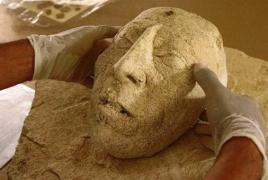
A life-sized stucco mask depicting one of ancient Mexico’s most well-known rulers has been discovered tucked away at the Mayan Palenque Palace, according to the country’s National Institute of Anthropology and History (INAH), IFL Scienc reports.
K’inich Janaab ‘Pakal, known as King Pakal the Great, became king of Mexico at the age of 12 and for 68 years ruled over the ancient Mayan city, chartering construction of some of the area’s finest architecture and elaborate building. Wrinkle lines around the mouth and cheeks of the mask represent him as an old man and, if proven to be him, would be the first of its kind.
"It is noteworthy, unlike other Mayan sites where representations are generic, in Palenque many of the features we see in [the] mural painting or stone carvings are faithful reflections of specific characters," said archaeologist Benito Venegas Duran in a statement.
The mask was discovered in a building called “House E”. Other ritualistic objects were also buried with the mask, including ceramic figures, pearls, fragments of jade, obsidian, a pyrite polished mirror, carved bones and flints, and skeletons of turtles, lizards, small birds, and snails. Palenque was a Maya city state in southern Mexico from 226 BC to AD 800 located near the Usumacinta River, archaeologists believe ancient residents had developed a special relationship with the river and offered objects to encourage its ecological sustainability.
Nearby, another structure (now called “House C”) would have been used around the same time. Archaeologists believe there was a pond to the northern end of a space between the two houses measuring 6.5 meters (21 feet) long by 3.5 meters (11.5 feet) wide and 20 to 30 centimeters (8 to 12 inches) deep. These two places have some of the best examples of mural painting in Palenque, one of which is the site where Pakal was crowned as a young boy, according to an oval tombstone depicting him receiving a headdress from his mother. Archaeologists also uncovered a figurine resembling a river shrimp, with lilies and fish accompanying it. Together, they believe these items represent the importance of the aquatic world in the area and the society’s reliance on the nearby river.
The archaeological team is working under a grant to restore the historic area to prevent future damage. They say they will conduct a structural analysis before continuing excavations.

